INDUSTRIAL &
TERMINAL RAILROADS &
RAIL-MARINE OPERATIONS
OF BROOKLYN, QUEENS, STATEN
ISLAND, BRONX &
MANHATTAN:
Bronx Terminal DL&W East One Hundred Thirty Fifth 135th Street Canal Harlem River Canal
| HARLEM
TRANSFER & RAILROAD Mott Haven, the Bronx, NY
ERIE, DELAWARE
LACKAWANNA & WESTERN AND |
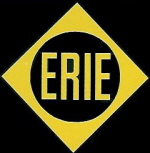 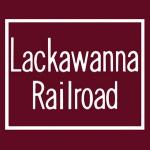 
|
.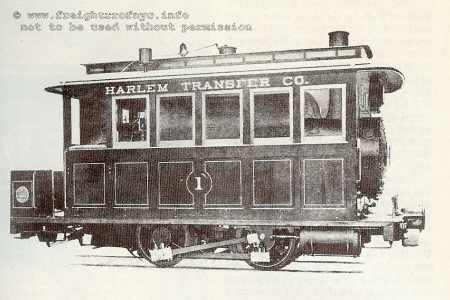
|
updated: |
||
|
|
||
|
update summary: |
date: | chapter: |
| 1935, 1947, 1951 Sanborn Fire Insurance Maps added |
01 January 2023 | Property & Facilities |
..
.
.

| Property & Facilities | Businesses | ||
| Float bridge | Locomotive Roster builders data, previous owners |
Marine Equipment Photos & Roster |
|
.. ..
.
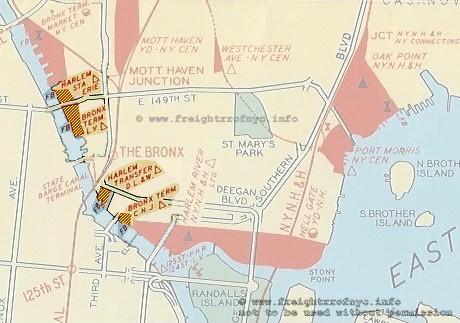
Port of New York Authority
New York Harbor Terminals, July 1943
.
.
The Harlem Transfer Company was organized in 1898 and was the first of the "pocket terminals" to be located in the Bronx along the Harlem River.
The Harlem Transfer Company was located at Park Avenue (formerly Railroad Avenue) and East 135th Street.
Originally it was built by, owned and operated by the Erie Railroad. It has been understood that sometime between 1898 and 1906, several other railroads would jointly operate in the facility.
When the Harlem Transfer facility opened for business, it's primary interchange partners were the Erie, Central Railroad of New Jersey and the Delaware, Lackawanna & Western Railroads. In 1902, the Baltimore & Ohio Railroad entered into agreement to interchange at this facility as well.
In 1906, the Delaware, Lackawanna & Western Railroad purchased the property outright and took control of the operations for their exclusive use, but kept the Harlem Transfer Company as a subsidiary with its own name, and leaving the other railroads to build their own carfloat terminals on the Harlem River. However, it appears the Erie Railroad would retain their presence at this facility through the 1930's.
Also, by referencing the Arrival Notice card in the Memorabilia Chapter, the Baltimore & Ohio Railroad is still listed with Delaware, Lackawanna & Western & Erie Railroads in 1907. So, the actual year that the Baltimore & Ohio Railroad presence ended at Harlem Transfer is uncertain..
The following image is an excerpt from the Delaware Lackawanna & Western Railroad's 1952 Directory of Industries and Facilities:

.
In terms of equipment, the Harlem Transfer would have their own tugboats and locomotives, which from all accounts were not shared with the Delaware Lackawanna & Western roster pool. Also, the construction of the freighthouse in this case, was unusual to say the least.
The Harlem Transfer Co. facility would close permanently in July of 1968. The tracks would be torn up and float bridge removed, but the circular freight house can still be seen standing in a 1974 aerial photo, and demolished by 1980.
According to Moody's Transportation Manual, 1979; the property was sold in 1978.
.
.
.
The following image, is an excerpt from page 233 of the Twenty-Eighth Annual Report of the Department of Docks & Ferries, City of New York for the year ending December 31, 1898.
It records the construction of the transfer bridge, freight house & tracks at the Harlem Terminal.

Twenty-Eighth Annual Report of the Department
of Docks & Ferries,
City of New York for the year ending December 31,
1898.
added 22 January 2010
.
| The newspaper article seen at right, which was published
in the September 26, 1898 edition of the New York Times; announces the opening
of the new "Erie Yards at Mott Haven".
At first glance, I thought it was referring to the Erie Railroads' Harlem Station. But careful reading reflected the location being discussed fronted at 135th Street and was located on the north side of the Mott Haven Canal. This could only mean the property being referred to in the article was none other than the Harlem Transfer property!
This article is
most interesting for several reasons:
It goes without saying, that the most interesting point of the article is the sole Erie Railroad ownership. This now raises the question, at what time did this Harlem facility become jointly owned, until that day in 1906 when the Delaware, Lackawanna & Western Railroad purchased it? |
|
Every once in a while something comes along that is really special. I acquired the following item on 17 January 2010. It is an original full page article that appeared in the December 22, 1898 issue of Engineering News. Can you believe this article is 112 years old and in such great condition?
I scanned it and left it a little larger than the original for ease of reading. Please take note, the compass rose in the plan is pointing the wrong way.
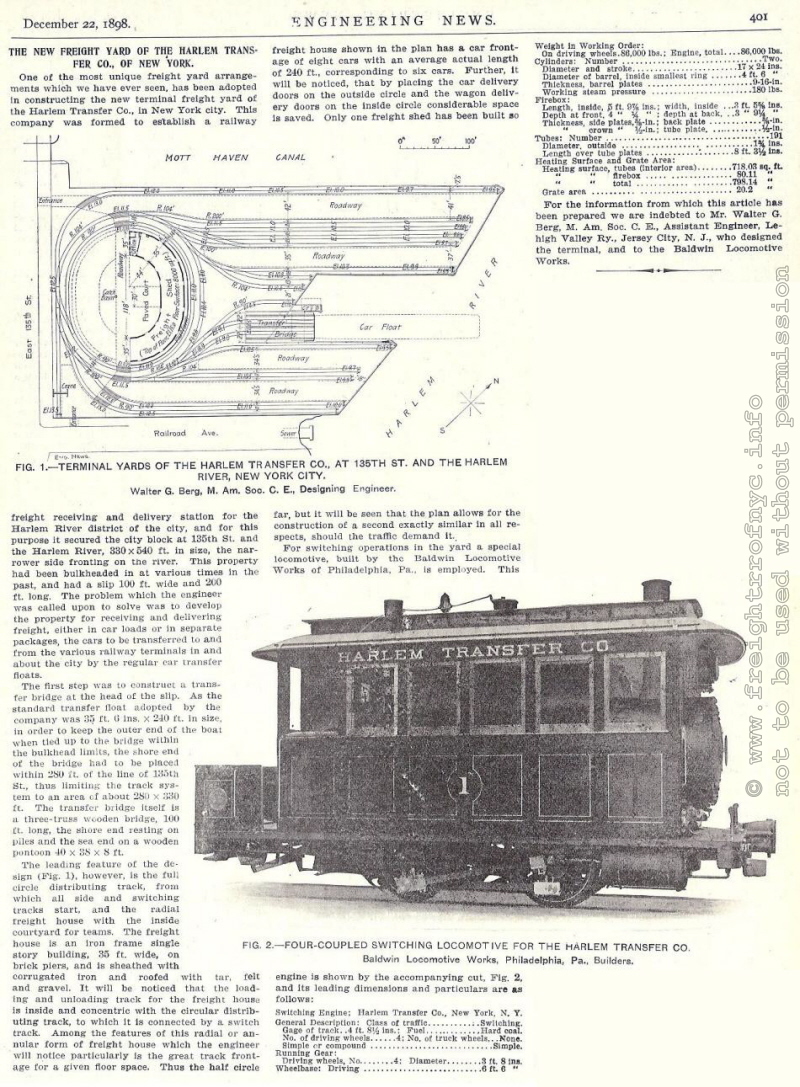
Engineering News - December 22, 1898
Please note: the compass rose is pointing 180
degrees in the wrong direction: south is north and vice versa)
authors
collection
added 18 February 2010
The Circular Freight House
The Harlem Transfer Company was designed by Walter Berg, a design engineer for the Lehigh Valley Railroad.
The challenge at that time was to fit a functional terminal design into the extremely small property footprint of 330 feet by 540 feet, to include the float bridge, freight house and team tracks. Berg's design offered a solution to the challenge and at the same time presented a novel idea for a terminal facility.
As originally constructed in 1898, the freight house was "C" shaped. The loading docks for trucks were on the inside hub or alcove, and the locomotives would spot cars by the respective loading platforms on the outside hub courtesy of some very tight trackage radii.
Berg's design called for a completely circular track layout utilizing minimum track radii of 90 foot, around the now recognizable semi-oval freight house design. This packed an incredible amount of serviceability into such a compact facility and as originally designed, the freight track on the outside wall of the freighthouse could accommodate seven standard sized 36 foot freight cars of the period.
The success of this design led to it being repeated, for in addition to the Harlem Transfer; the Central Railroad of New Jersey "Bronx Terminal" and the Lehigh Valley "Bronx Terminal" facilities had circular freighthouses and concentric circular trackage as well.
The original semi-circular freighthouse was a tall (high ceiling) one story structure, 35 feet wide, with an aggregate length of 188 feet and offered 8000 square foot storage capacity on each floor. The office on the end however was two story.
According to the legend on the Bromley map index, pink structures denote brick construction, yellow structures are wood frame construction, stone / concrete construction in light brown, and iron or metal sheathed wood construction is yellow with blue outline, and yellow with pink outline is wood structure with brick sheathing..
|
|
|
.
.
The G. W. Bromley Map of 1911, (above left) shows us that the original design of the track layout, which appears to have included a spur that ran in Park Ave (Railroad Avenue). The purpose of this track or to whom it serviced, is unknown. It also appears in this map, that a wye was located between the freighthouse and carfloat slip. This wye does not appear in any of the track diagrams below and it should be kept in mind that property maps should not be substituted for actual track plans, as their degree of accuracy was not high.
These property maps do serve a purpose however, and show significant changes, additions and removal of structures. As we we can see in the 1928 Bromley map (above right), that "street" trackage would be removed, along with the wye and a small reconfiguration of the north and center yard trackage and a one story structure is now located at the foot of the slip.
Note both maps show the property to be operated by "Lackawanna & Erie RR Co." (two separate Railroad companies).
The following image, a Fairchild Aerial Survey Photo taken in 1924, shows us that both the west and east freighthouses existed at this date.
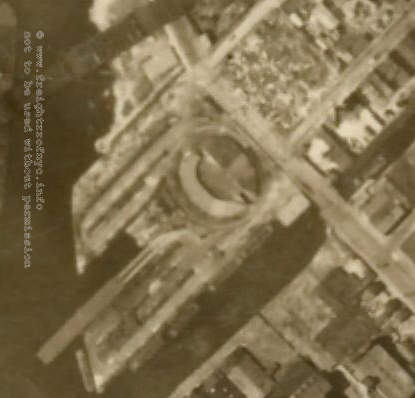
Fairchild Aerial Survey Photo - 1924
NYPL archives
.
.
Interstate Commerce Commission Valuation Map - 1928
Neil Smith of the United Kingdom was kind enough to provide a high resolution scan of an actual Interstate Commerce Commission Valuation Map of which he secured a copy of, from the National Archives.
Neil is in the process of planning a scale layout of the Harlem Transfer. In return for providing this map, Neil is hoping that some of you readers might be able to provide photographs of some / any of the structures on the Harlem Transfer property. I think it goes without saying, I would not mind some photographs of those structures either.
The image size is huge, although I have already reduced its size to make viewing a little more convenient, so please be patient while the file opens. This Interstate Commerce Commission Valuation Map is of great use to us as it lists early tenants and their respective structure locations on the property of the Harlem Transfer.
There are several items worth taking note of in this map:
.
The fact the the map was drawn by the "Office of Chief Engineer, Hoboken, NJ". This can only be interpreted as being the office of the Chief Engineer of the Delaware, Lackawanna & Western Railroad, as their offices were located in Hoboken and were the parent organization of the Harlem Transfer.
The gantlet track arrangement is very noticeable on the float bridge.
The west crossover from the inner loop to the outer loop does not exist yet at the date of revision.
A flatcar ramp located at the northeast corner of the slip.
.
"Clicking" on the the following image will take you to a large scale version of that image for review. Use the back arrow to return you here:
.
| The 1942 G. W. Bromley map to the right is of much more
use to us, as this version now lists the occupants of some of the
structures.
Note "Erie RR" has been removed from under "Harlem Transfer" leaving the Lackawanna (Delaware, Lackawanna & Western) Railroad as the sole operator. The Blue Ridge Coal Company apparently has established a set of coal silos on the property of the Harlem Transfer, and these coal silos can be seen in a photo of locomotive #2 below. From what can be ascertained from that photo, a bucket conveyor transferred coal from a pit between the tracks to the top of the silo, as no trestle can be seen. Trucks would be driven underneath the silos, and coal dispensed into the truck. Blue Ridge also occupied the plot of land north of the Harlem Transfer just across Park Avenue. Mott Pipe Supply was due east of the Blue Ridge property. It is unconfirmed if there was rail service to this pipe supplier. Cramer, Meyer, Dreyer Coal had a structure in the northeast corner of the Harlem Transfer property (south west corner of Park Avenue and East 135th Street. This structure is located where the gantry crane was located in the track diagrams illustrated below. Grossmac Flour Trucking is believed to have occupied the one story steel structure at the foot of the Mott Haven Canal / Basin and had a dedicated siding in the southeast corner of the yard In 1957, the first or west freight house was rebuilt with cement block construction. |
|
However it is unknown at this time whether the east freight house was rebuilt from a previously constructed building. In either case, the aerial view of the Harlem Terminal was now that the two semi-circular freight houses appeared like parenthesis: ( ) . See images below.
Sometime after 1957 and before 1966, the area over the court yard and driveways was roofed over, providing a completely enclosed oval structure.
Sanborn Fire Maps
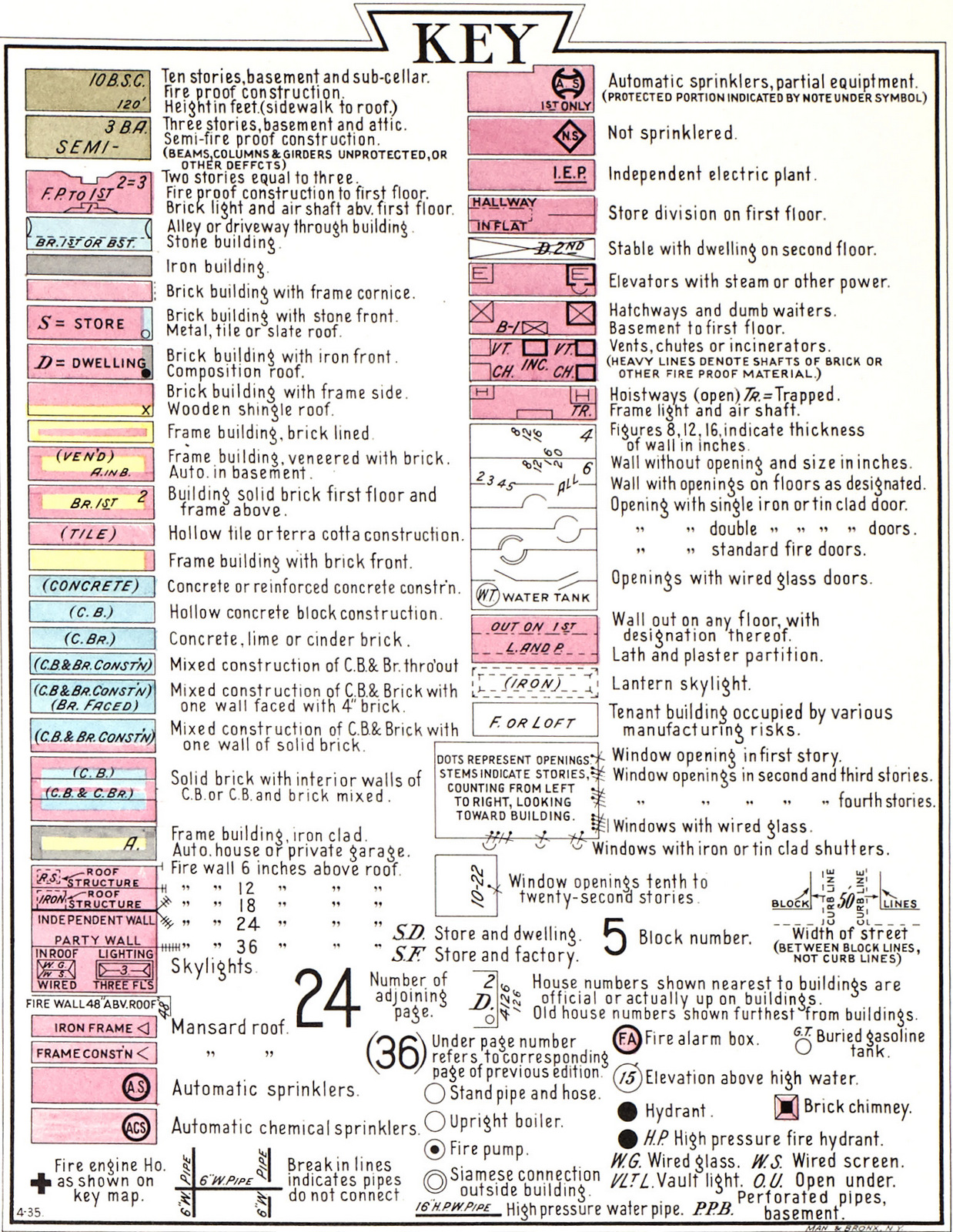 |
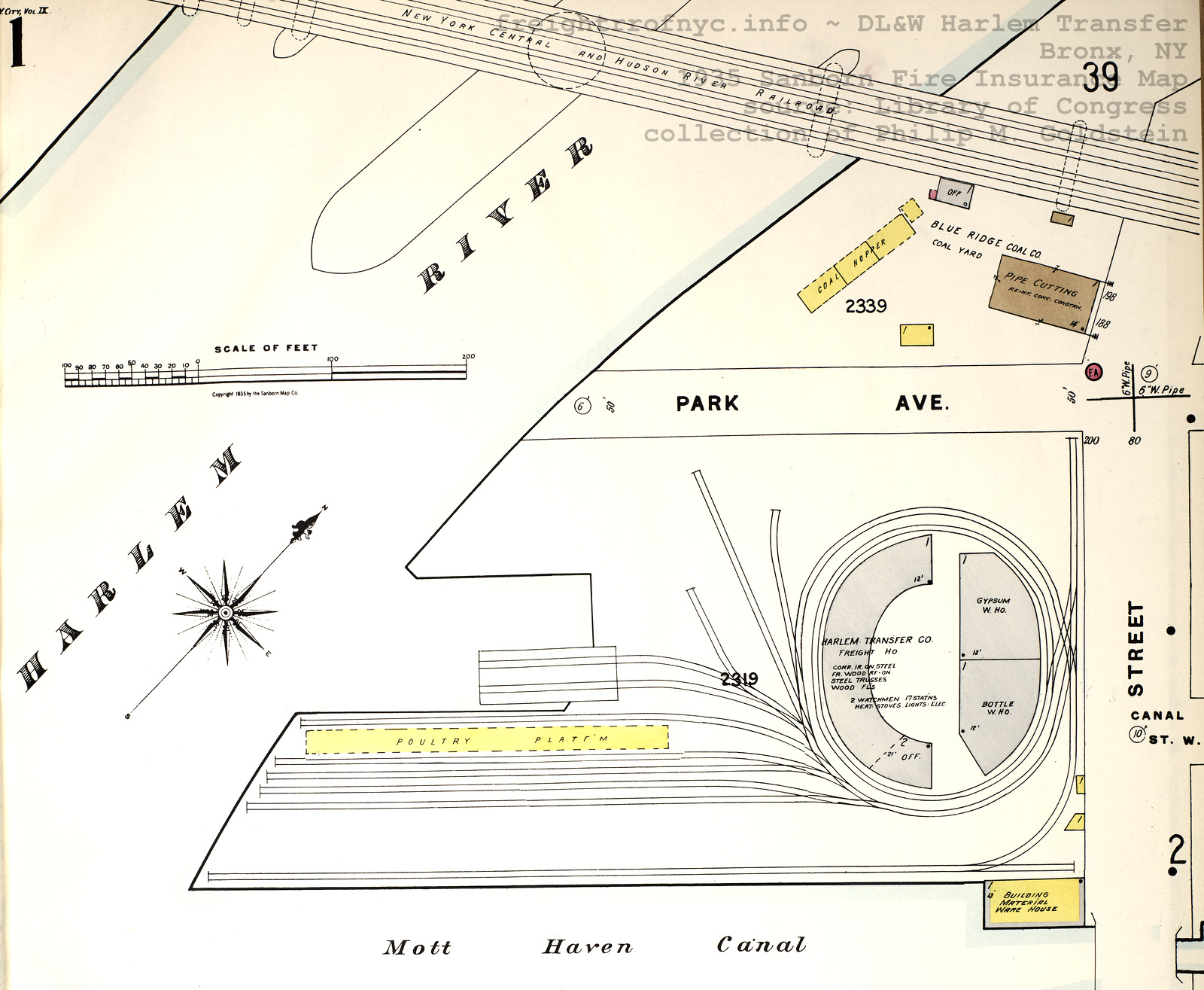 |
| Sanborn Fire Insurance Map - 1935 Library of Congress authors collection added 01 January 2023 |
|
| . | |
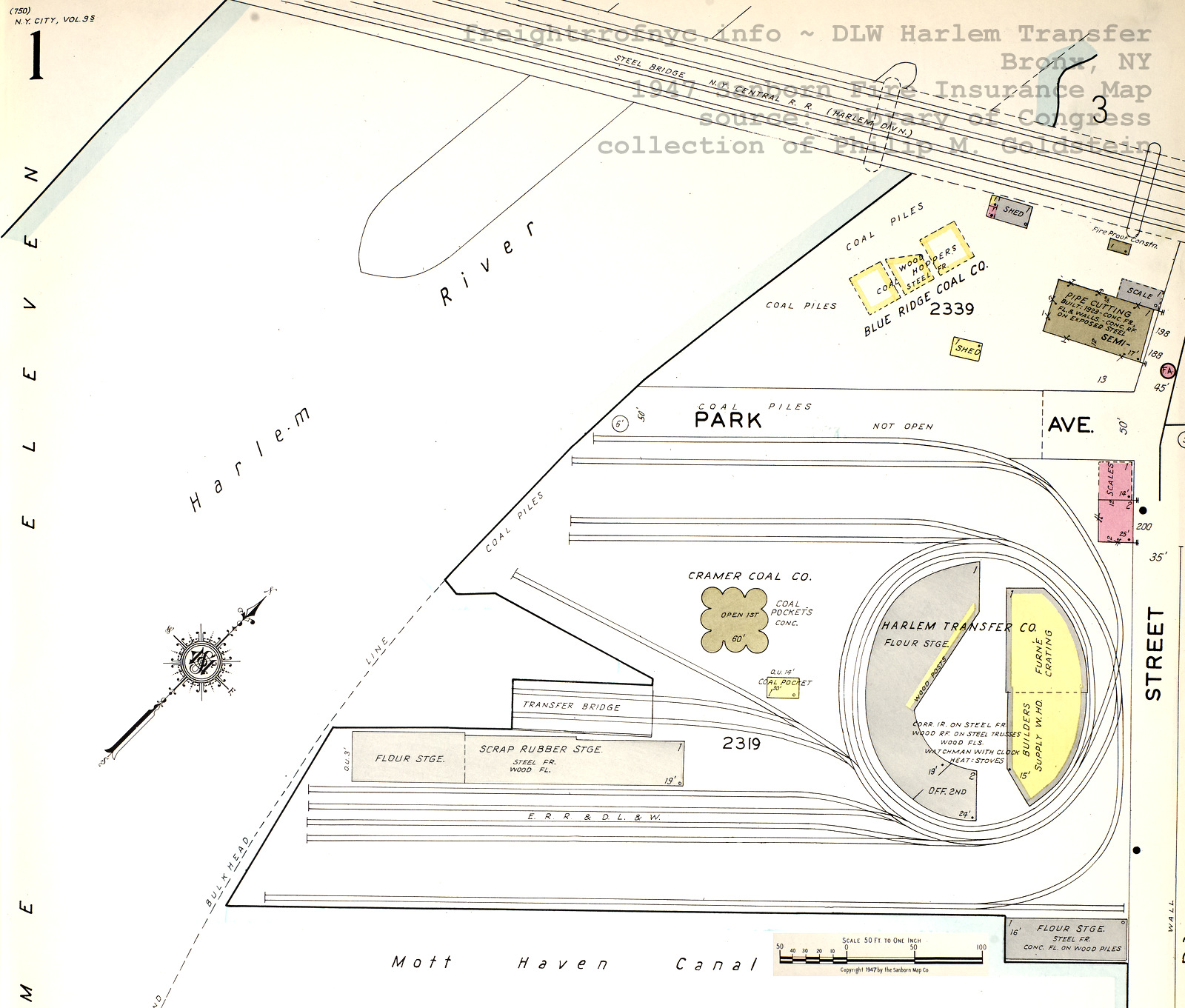 |
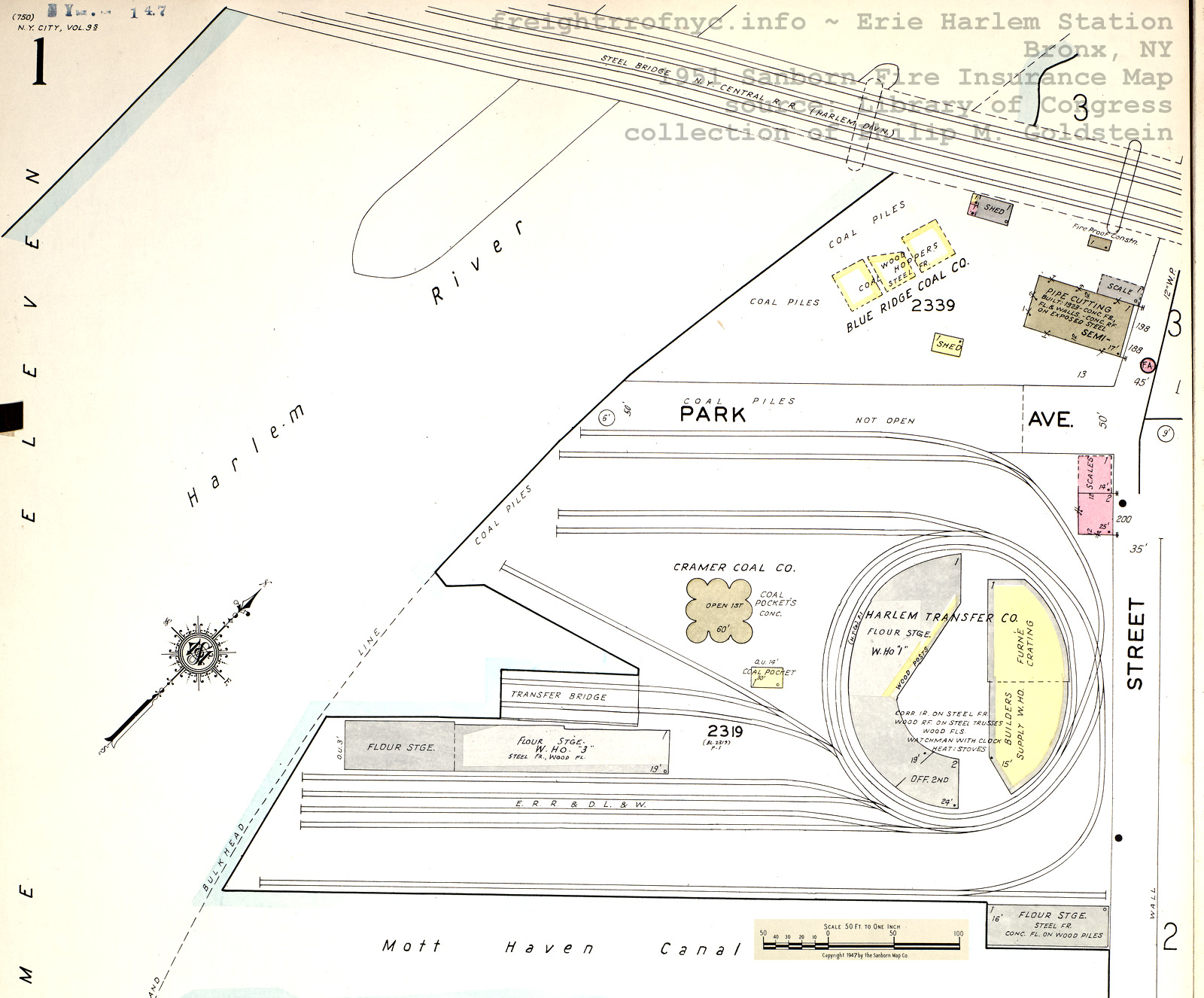 |
| Sanborn Fire Insurance Map - 1947 Library of Congress authors collection added 01 January 2023 |
Sanborn Fire Insurance Map - 1951 Library of Congress authors collection added 01 January 2023 |
.
.
This list is a compilation of businesses located at or a regular consignees throughout the history of the Harlem Transfer. Some of these businesses would be located within or on Harlem Transfer property, while others might have property adjoining or across a street from the Harlem Transfer property.
By no means is this list complete, and dates are estimated when preceded or followed by arrows.
|
name |
dates of service |
| Acme Transfer & Storage | < 1928 > |
| Anderson Brick & Supply | |
| N. B. Bahr Trucking | < 1928 > |
| Blue Ridge Coal Co. | < 1942 - ca. 1960 |
| Cramer, Meyer, Dreyer Coal Co. | < 1942 - mid 1950's |
| Grossmac Flour Trucking Co. | |
| Mott Haven Towing | < 1928 > |
| Mott Pipe & Supply ? | < 1942 |
| N. T. Swezey's Son & Co. | < 1928 > |
The following was submitted to me via email from Nick Panebianco on April 8, 2009; following his offer of information when he signed the guestbook of this website:
What I have are stories I’ve been told, some names of people and companies and some things I witnessed myself. For example:
"The Harlem Transfer had a tenant coal company, Cramer, Meyer & Dryer in your information. This later became Cramer Coal which my father had a contract to buy in the mid fifties. His deal fell through and Cramer sold to Blue Ridge Coal which had the metal silos north of Harlem Transfer. When the acquisition was done, Blue Ridge moved into Cramer’s concrete silos on the HT property.
Sometime in the summer of 1969 I think, the lease was up and Blue Ridge was required to remove all the buildings on the site at their expense. They knocked down the brick office and scale house themselves with an old AC Mack truck mounted crane. Shortly after that the locomotive disappeared and the warehouse was used only by truck for a short time."
The following images were forwarded to me by Jon Baker, of whom is becoming a regular contributor to this website.
The original images reside in the archives of the Steamtown National Historic Site located in Scranton, PA; and are used with the permission of that institution via Patrick McKnight, historian / archivist of Steamtown NHS. The images are part of the Delaware, Lackawanna &Western Railroad's Chief Engineer's files.
|
|
| .
. |
|
|
| .
. |
|
|
.
.
The following article was discovered within the Official Proceedings of September 1900 for the monthly meeting of the Western Railway Club. In this discussion, it specifies the design and components of the trackage, as well as the freighthouse and how the locomotive is used at the Harlem Terminal:
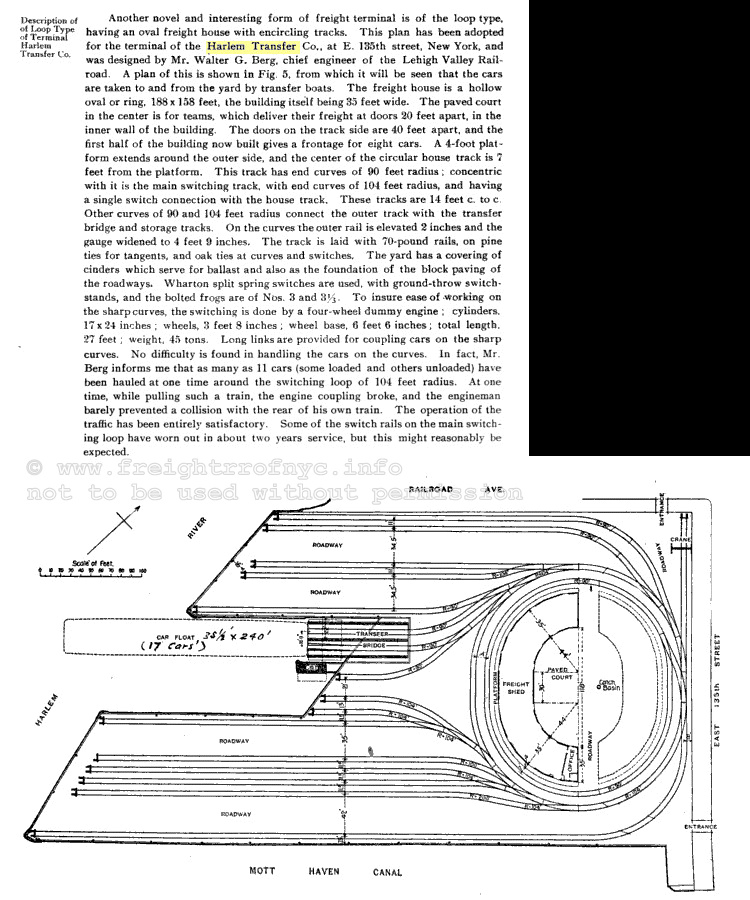
Official Proceedings of the Western Railway Club -
September 1900
added 22 October 2010
.
Also, mentioned in "Notes on Track Construction and Maintenance" by W. M. Camp, 1904; that the curves on the Harlem Transfer trackage were gauged at 4 feet 9 inches (not the standard 4 feet 8.5 inches) and the outside rail of the curve was elevated 2" from the inner rail.
Also due to the nature of tight radii, special long links were used in coupling of the locomotive to cars (before link & pin couplers were replaced with the Janney coupler).
The graphic below comes from the 1912 book "Freight Terminals and Trains" by John Droege. In this graphic, the track radii are listed. Note that the east freight building (right side) is shown.
It appears that this diagram and the one in the Western Railway Club article above are identical, minus the handwritten dimensions of the carfloat and its capacity.
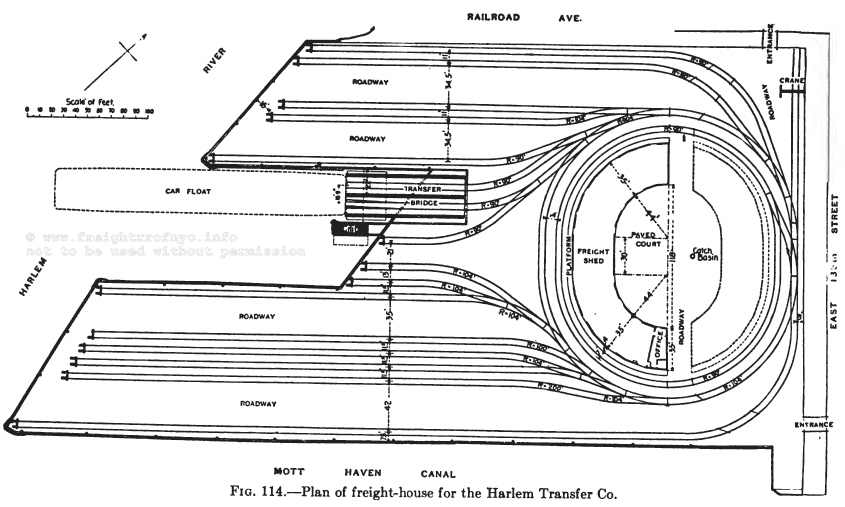
Freight Terminals and Trains - 1912
J. Droege
.
.
According to the "Report of the Committee on Terminals and Transportation of the New York State Food Investigating Commission" published April 18, 1913; it lists the capacity of the freight house at the Harlem Transfer 19,964 square feet with 1.48 miles of trackage.
The following graphic is from the Harlem Transfer Company letterhead. It is currently unknown from which time frame this letterhead was printed and used. There are a few minor differences in this track diagram when compared to the one above, and of which do not appear in the other diagram below. These minor differences are worthy of discussing here.
The first of these differences are a one car stub track near the float bridge. The location of this one car stub track makes little sense, as it is not near any vehicular driveways or loading docks and is in very close proximity to the "running" trackage of the outer loop, therefore is would provide limited access for transferring freight. The possibility exists that this track could have been used as a storage track for the locomotive.
The second difference between diagrams, is a crossover from the inner loop track to the outer loop track next to the one car stub track. This crossover is located to the left of the "T" in "Freight House". The location of this "west" cross over makes perfect sense, as it would add greater access to the inner loop track and therefore greater flexibility in spotting cars along the west freight house walls should cars be occupying the inner loop track along the east freight house walls, which by nature would block the east crossover.
The third difference is that the east freighthouse is shown as dashed lines, as if it were proposed but not constructed yet.
Furthermore, this letterhead graphic clearly shows the track capacities for the Harlem Transfer Company. By adding up the numbers, we ascertain that the Harlem Transfer has a total car capacity of 123 cars:
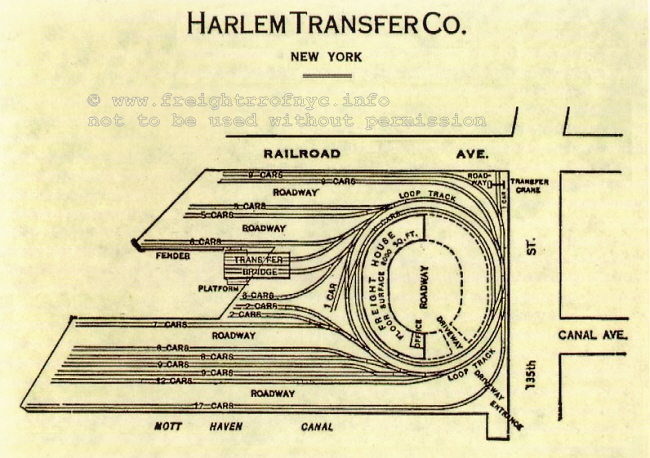
letterhead of Harlem Transfer Company - March
1923
.
.
In the following drawing both track radii and elevations are listed. However, this drawing it is oriented with south being up, but the compass rose is pointing 180 degrees in the wrong direction!
Again, the east freighthouse is shown as dashed lines, as if it were proposed but not constructed yet.
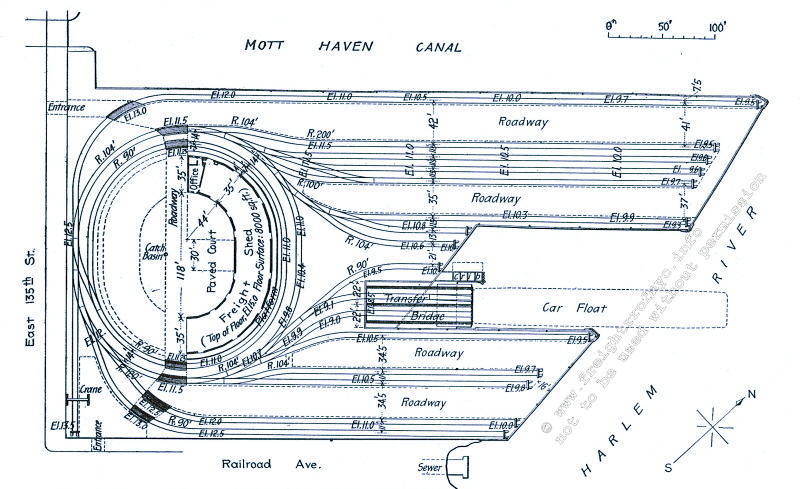
This drawing originally appeared in the December
22, 1898 issue of "Engineering News" (original at top of page)
and was reproduced in the "Train Sheet" Vol... XIV, No. 2, 1959.
Please note: the compass rose is pointing 180 degrees in the wrong
direction: south is north and vice
versa)
.
.
.
.
In 1913, the float bridge would be relocated to the south side of the slip (or bottom) to keep the Terminal in use whilst the Lexington Avenue subway tunnel was under construction. However, all graphics with the exception of the Port Series Map show the float bridge to be located in the north position.
As far as it has been researched, this facility originally had a wood Howe Truss float bridge in the early years, which was common before and around the turn of the century; when this terminal was first organized.
Sometime in the 1950's, the original wood construction Howe truss floatbridge was replaced with a steel pony plate girder.
Of a slightly unusual arrangement and another unique feature of this facility, is the long "gantlet" track paralleling the left float bridge track. In this case, this gantlet track accessed the middle track of three track interchange carfloats. On the majority of float bridges at other locations, a low profile switch throw was mounted near the end of the float bridge between the rails, shortening the distance for access to the middle track.
In relocating the switch to land however, some ninety plus feet away from the actual center track; required a "gantlet track" arrangement on the float bridge:
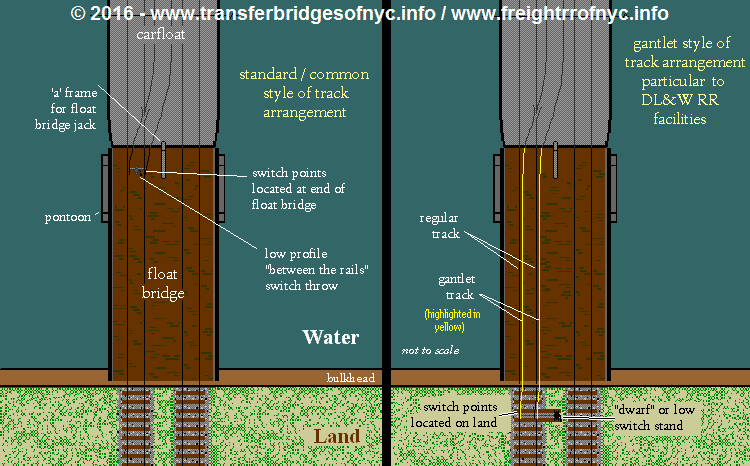
.
It appears that the Delaware, Lackawanna & Western Railroad preferred this gantlet track set up, as they also used this same gantlet track arrangements at their 25th Street Terminal in Brooklyn, as well as the many float bridges at their main facility in Hoboken, NJ.
The following Port Series Map, which is "bland" in track detail when compared to the detailed diagrams above, has been included for a very interesting reason. The float bridge as depicted in the Port Series Map is on the south side of the slip. All other drawings above show it on the north side!
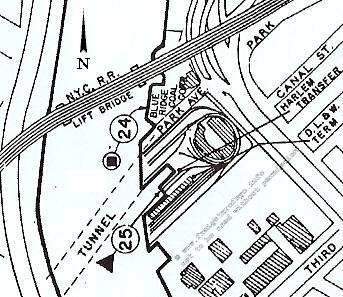
Army Corp of Engineers Port Series Map
(float bridge now shown as relocated)
.
.
In either of the two locations (south side or north side of slip) of the float bridge at Harlem Transfer, the float bridge was oriented perpendicular to the Harlem River. This meant that when a carfloat was "bridged" (attached to the float bridge) it was jutting out into the Harlem River, which presented an obstruction to marine traffic.
While the Lehigh Valley Bronx Terminal float bridge orientation would originally be constructed perpendicular to the Harlem River, it is recorded that that facility would be reconstructed, and at such time, the float bridge would be reorientated to be almost parallel with the Harlem River.
It is unknown why the Harlem Transfer facility would not undertake a similar reconfiguration to reduce the level of obstruction to vessels navigating the Harlem River, and this facility would retain the perpendicular float bridge orientation until closure.
.
.
The Harlem Transfer Company would come
to own only three, but very distinct locomotives over it's
history.
.
Steam Locomotive: Baldwin 0-4-0T Saddletank
The first locomotive to be employed by Harlem Transfer was a steam powered 0-4-0T constructed by Baldwin Locomotive Works in July of 1898. This locomotive was originally built as a "steam dummy" and was coal fired. According to the 1898 New York Times article, this locomotive was called a "Puffer".
"Steam dummies" were nothing more than a simple tank style steam locomotive built with a faux street car shell over the chassis. They were also known as "over all cabs". This was a common practice back in the era when horses were the primary power of transportation, and supposedly were accustomed to street cars, yet were were easily frightened by the moving parts and escaping steam of a conventional steam locomotive.
As the street car shell hid all the reciprocating machinery, apparently horses were more at ease in their presence with this arrangement. Sadly, as horses were no longer a factor in daily transportation due to the advent of the internal combustion engine; and as cars & trucks are not scared of steam locomotives; Number 1 was converted to a conventional saddletanker.
.
Ingersoll - Rand 60 Ton - 300 h.p Boxcab
Pursuant to the initial ratification of the Kaufman Act, this facility would see the acquisition of one of the new A/GE/IR boxcabs developed to allow the railroad to comply with the act.
You can read the comprehensive history of all steam locomotive restrictions for the City of New York, beginning 1834 and ending with the Kaufman Act and its repeal on the main page of this website: Steam Locomotive Regulations within the City of New York. It is very much worth a read, because there are misconceptions and omissions in discussion about the Kaufman Act, i.e. such as it was ruled unconstitutional in 1926 and repealed in 1930.
This coincided with Ingersoll - Rand's development of an internal combustion boxcab locomotive.
The second locomotive used at Harlem Transfer would be a 60 ton diesel-electric boxcab model manufactured by American Locomotive / General Electric / Ingersoll Rand. The Delaware, Lackawanna & Western Railroad would order this locomotive new in 1926 as Delaware, Lackawanna & Western #3002, but would have this unit lettered specifically for and delivered to the Harlem Transfer Company facility. It was assigned the number 2 and this locomotive would see use until 1962.
Of particular interest is the fact that this boxcab diesel-electric locomotive was a identical sister to the Delaware, Lackawanna & Western #3001, which was assigned to the Delaware, Lackawanna & Western Railroad's 25th Street Terminal (former Brooklyn Dock & Terminal), located in Brooklyn.
.
General Electric 44 Ton
The third and last locomotive to serve at Harlem Transfer and of which replaced #2, was a "hand me down". This locomotive was constructed by General Electric and was a 44 ton centercab switcher, numbered #53. This locomotive was transferred to the Harlem Transfer facility around 1964, from the Delaware, Lackawanna & Western Railroad's 25th Street Terminal located in Brooklyn, when the 25th Street Terminal was closed.
This locomotive would be re-lettered for Harlem Transfer and it would serve at this location until the closure of the Harlem Terminal facility ca. 1968. This locomotive can be seen in various photos wearing Lackawanna or Harlem Transfer liveries, and even seen in one photo with Harlem Transfer peeling and Lackawanna visible underneath.
#53 was built along with two sisters, #51 and #52. While both #51 and #53 would be photographed having worked the 25th Street Terminal (prior to its closure) on seperate dates. It is not believed that either of #53's sister worked the Harlem Transfer. The disposition of this locomotive is unknown.
..
|
|
| .
. |
|
|
| .
. |
|
|
| .
. |
|
|
| .
. |
|
|
| .
. |
|
|
| .
. |
|
|
| .
. |
|
|
| .
. |
|
|
| .
. |
|
|
| .
. |
|
|
| .
. |
|
|
| .
. |
|
|
| .
. |
|
|
| .
. |
|
|
| .
. |
|
|
| .
. |
|
|
| .
. |
|
|
| .
. |
|
|
| .
. |
|
|
| .
. |
|
|
| .
. |
|
|
| .
. |
|
|
| .
. |
|
|
| .
. |
|
|
| .
. |
|
|
| .
. |
|
|
| .
. |
|
|
| .
. |
|
|
| .
. |
|
|
| .
. |
|
|
| .
. |
|
|
.
Harlem Transfer Locomotive
Roster
| number / name | builder | c/n | build date |
gauge |
wheel arrangement |
wheel dia. |
cylinders |
acquired |
disposition |
notes | ref |
| #1 | Baldwin | 16030 | 7/1898 | std. | 0-4-0T | 44" | 17" x 24" | new | sold 4/1942 to Drydock Ass'n of Norfolk |
length: 27' weight: 90,000 (82,000?) lbs. wheelbase: 6' 6" |
[2] [33] |
| #2 | ALCo/GE | 66684 10027 |
6/1926 | std. | B-B | new | retired 2/1962 scrapped 11/1962 |
60 Ton boxcab ordered as DL&W #3002 |
[1] | ||
| #406 / #323 | ALCo | 68640 | 12/28/1933 | std. | B-B | new | scrapped, Meadville, PA 1964 | 600 hp High Hood renumbered Erie Lackawanna #323 seen in photo in Alco HH series book photo with caption "at the Bronx, NY" w/ HT #2 and credited to J. R. Quinn. Possibly used as relief loco when HT #2 needed inspection / servicing. |
|||
| #53 | GE | 29988 | 11/12/1948 | std. | B-B | used ex-DLW #53 |
1968 to Weston & Brooker Quarry #53,
Camak, GA; to Martin-Marietta, re# 18562, transferred to Martin-Marietta, Camak, GA; transferred to Martin-Marietta, Warrenton, GA |
44 Ton centercab Order? SG3 Model B-B-88/88-4GE733 ex-DLW (25th St Terminal) #53 [a] |
[23] [55] |
Locomotive Footnotes
| [a] | weight: gear ratio: |
89,000 lbs. 11.25:1 |
.
.
There were three tugboats assigned to service Harlem Transfer Company.
The tugboats, like the rest of the Harlem Transfer operation, would be unusual in their own way. Because the Harlem Transfer Company was located on the Harlem River, which to this day; has low clearance road bridges spanning the waterway from Bronx to Manhattan, required "lower" marine vessels to ply this waterway.
The bridges that were built were of movable type (mostly swing type), but in the early decades of the twentieth century when river traffic was heavy, would have required the road bridges to open very frequently throughout the day, and thereby disrupting vehicular traffic constantly.
To help ease this disruption, several tugboats would be designed with lower smokestacks and lower wheelhouses to fit under the swing and vertical lift bridges along the Harlem River, and so as not to have the bridges open up and impede the flow of vehicular / rail traffic as frequently.
Charles Gerow, a New York Harbor Pilot (retired) based out of Sandy Hook, offered this explanation:
"the [lower] tugs were used NOT to avoid impeding road traffic, but to avoid being hung up by an obstinant draw tender, particularly if you had a fair tidal current pushing you."
This explanation makes good sense too, as it would not be well off for the tug crew (or the bridge tender!) to hit the drawbridge.
The following image shows the easily recognizable differences between a "Harlem River" tugboat (on left) which could navigate the Harlem River without requiring bridges to open, as opposed to a standard profile railroad tugboat (on right) which could not:

.
.
It should also be noted that railroad terminals located along the Harlem River were imposed with physical restriction on the transport of carfloats. One must consider the narrow width of the channels between the swingbridge center island fender and end abutments. Therefore any tugboats transporting carfloats to any of the terminals located in the Bronx, would have to transport those carfloats singly.
The tugboats which serviced the Harlem Transfer Facility were the "Commander" and the "Bronx", After the 1960 merger of the Erie and the Delaware, Lackawanna & Western, the "Rochester" would service both Erie Harlem Station and Harlem Transfer..
According to all the shipbuilding records I have referenced to date, I can only find two carfloats built specifically for the Harlem Transfer Company; those being the HT #1 & HT #2 , built by New York Shipbuilding.
This is not to say tugboats from other railroads were not used to transfer cars to and from the Harlem Transfer facility. As the Erie and Baltimore & Ohio Railroads also were partners in the Harlem Transfer facility, they would also have tugboats that could ply the Harlem River.
The Baltimore & Ohio Railroad "Harlem River" tugboat was the J. W. Phipps, Jr. ?This tugboat was formerly the CRRNJ tug "Liberty".
In 1960, the Erie Railroad would merge with the Delaware, Lackawanna & Western Railroad, forming the Erie - Lackawanna Railroad. Due to this merger, Erie - Lackawanna tugboats and carfloats would service both the Harlem Station and Harlem Transfer facilities in unison.
.
Carfloats
It should also be noted that carfloats servicing the Harlem Transfer facility, due to the orientation of the float bridge, necessated the use of a shorter carfloat than that of one regularly used at other offline terminals.
The following excerpt is from an internal memorandum regarding the clsure of the Wallabout Terminal. The memo was issued by the Office of Superintendent, Delaware Lackawanna & Western RR, Hoboken, NJ. At the time of this letter, which is dated November 11, 1941; the Superintendent was Perry Shoemaker:

Most if not all railroads had "shortie" carfloats, that could be used at the Harlem Transfer , so there is in all probability others used here as well.
..
|
|
| .
. |
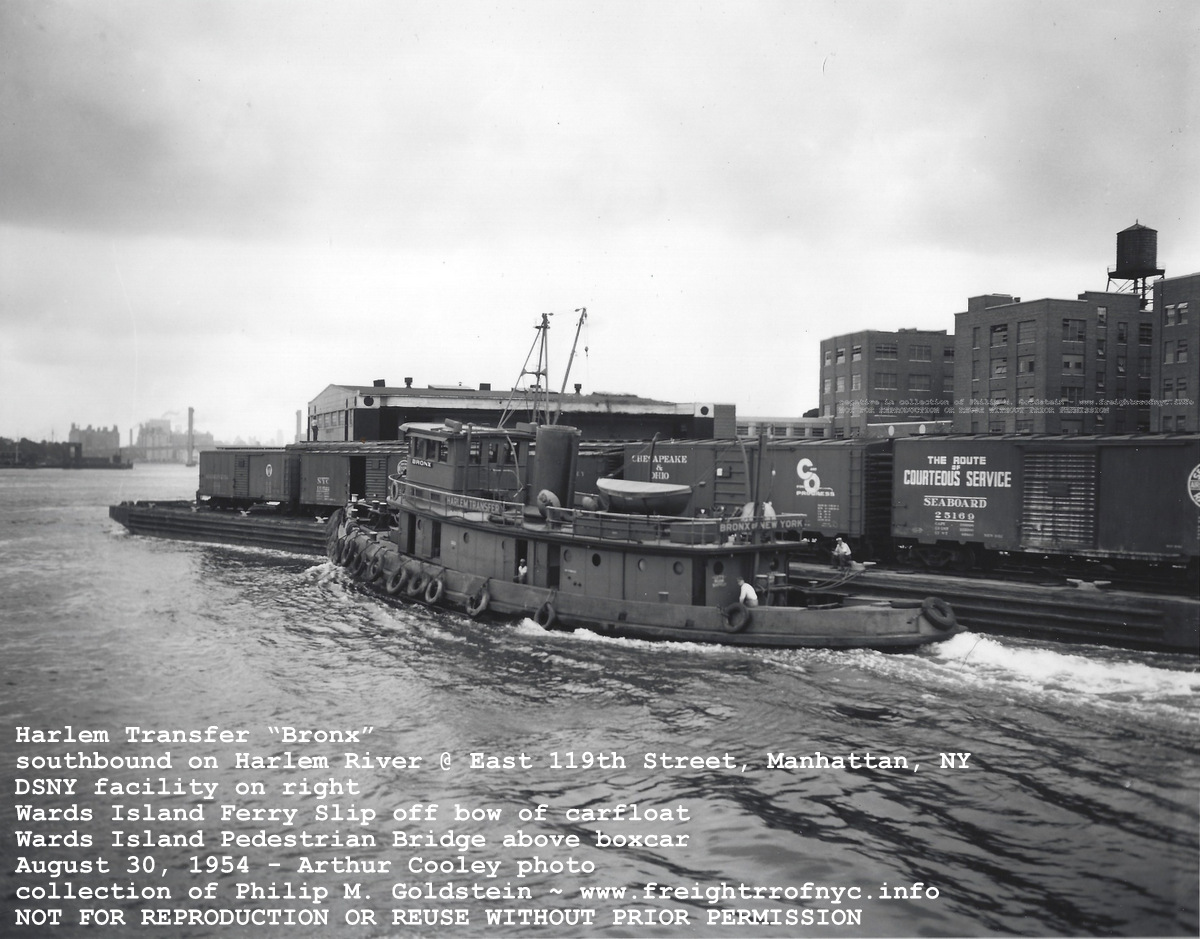 |
| .
. |
|
|
| .
. |
|
|
| .
. |
|
|
|
.
. |
|
|
| .
. |
|
|
| .
. |
|
|
.
.
..
Harlem Transfer Tugboat & Carfloat
Roster
|
|
||||||||||||||||||||||||||||||||||||||||||||||||||||||||||||||||||||||||||||||||||||||||||||||||||||||||||||||||||||||||||||||||||||||||||||||||||||||||||||||||||||||||||||||||||||||||||||||||||||||||||||||||||||||||||||||||||||||||||||||||||||||||||||||||||||||||||||||||||||||||||||||||||||||||||||||||||||||||||||||||||||||||||||||||||||||||||||||||||||||||||||||||||||||||||||||||||||||||||||||||||||||||||||||||||||||||||||||||||||||||||||||||||||||||||||||||||||||||||||||||||||||||||||||||||||||||||||||||||||
Tugboat Footnotes:
The following specifications are taken from Johnson's Steam Vessels, 1920
|
|
.... |
|
||||||||||||||||||||||||||||||||||||||||||||||||||||||||||||||||||||||||
.
.
|
|
| .
. |
|
|
| .
. |
|
|
.
..
.
Like what you see? Suggestions?
Comments?